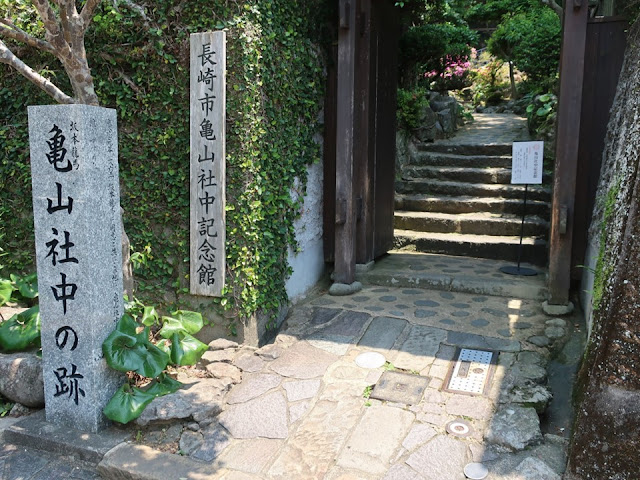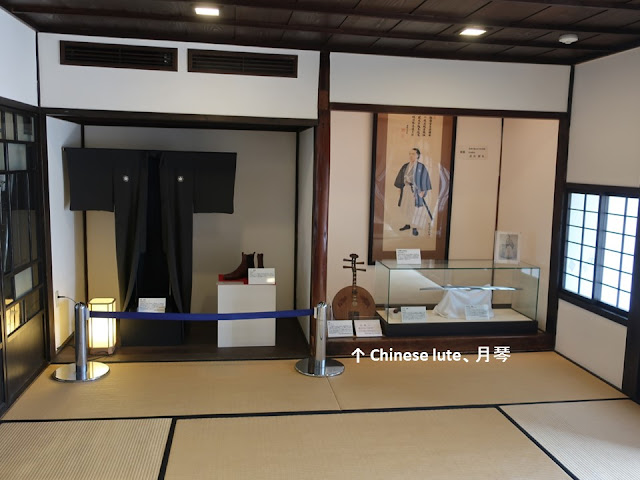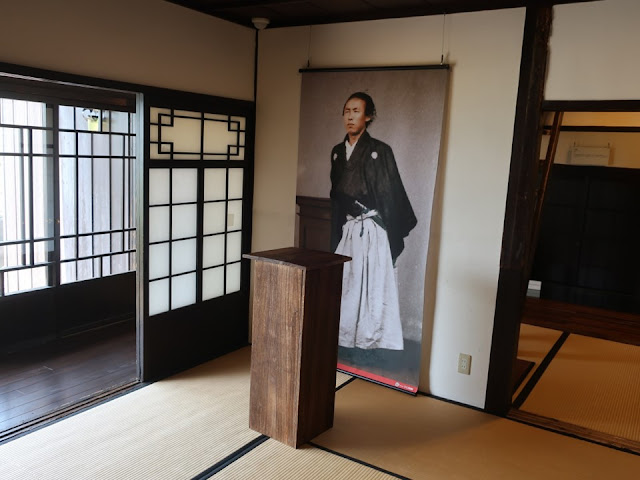The small wooden museum in Nagasaki City in western Japan is the place where the hero in the end of Edo period (1603~1868) stationed.
His
name is “Sakamoto Ryoma” (1864-1867) who was a lower-class samurai, but
it is said that he contributed to change ruler from the shogun to the
emperor a lot (Meiji Restoration). He was very popular
among Japanese even now, because of his dynamic lifestyle. Sadly, he was
assassinated just before the new government (Meiji) started when he was
thirty-one.
長崎市の亀山社中記念館は、倒幕の熱い志を持った坂本龍馬が亀山社中の拠点を置いた建物です。元々は、亀山焼を扱っていた家でした。
龍馬といえば、多くの人は司馬遼太郎の小説を通して彼を知り、感銘を受けています。職員さんによると、司馬氏が調査に来たときは、玄関側の二間(現在の事務所と第一展示室)が亀山社中が使っている場所と考えられていて、「龍馬が来る」もそのイメージで書かれたそうです。でも、後で、長崎の街を望む庭側の二間(現在の第一展示室と第二展示室)を使っていたことが分かったそうです。マニアックな話ですが。
The uphill road to the museum is named “Ryoma Street”.
記念館への登り道は「龍馬通り」と名付けられています。
The gateway of the museum is at the middle of the steep slope.
急坂の途中に記念館の入口があります。
The entrance is on the left. It’s very narrow.
玄関は左側、とても狭いです。
We can enter two rooms. At the first room, replicas of Ryoma’s belongings. The Chinese lute is the equivalent one which his wife learned. The hanging scroll was donated by a famous actor (Takeda Tetsuya) who is a big fan of Ryoma.
拝見できるのは二室で、玄関寄りの第一展示室には龍馬が使用した品の複製や同等品が置かれています。肖像画は名誉館長の武田鉄矢さんが寄贈した物。顔が武田鉄矢に似ているという人が多いそうです。確かに。月琴は、妻のおりょうさんが習っていたということで置かれています。
We can take a photo in front of Ryoma. The room behind is the second exhibition room, but photography is prohibited. Exhibits are replicas such as the folding screen in the room where he was killed, his letters to his family, his favorite tea cup and so on.
龍馬のポーズで写真を撮れるコーナーもあります。奥の第二展示室には、次の複製品が展示されていますが、撮影は禁止です。
・記念館の1/40模型
・龍馬愛用の飯椀・湯呑み(長府博物館蔵)
・坂本乙女、おりょうへの手紙(京都国立博物館蔵)
・海援隊規約、隊士写真
The scratched pillar and beam have been there since Ryoma resided.
傷んだ柱や鴨居も龍馬がいた頃からの物だそうです。そう思うと、感慨深いですね。
Nagasaki City behind the small garden is much different from the one while Ryoma was. However, land features are same. The thing we do is to enjoy the Ryoma’s former house and its atmosphere.
小さな庭越しの長崎の街は、龍馬の頃とはすっかり変わったと思いますが、地形は同じです。ここは展示品ではなく、住居と雰囲気を楽しむ記念館ですね。
The photo above is a view of the garden from the outside. The narrow road and the steep slope prevented me to take a photo of the whole building.
屋外から見た庭の部分です。急斜面で道が狭く、全体の写真を撮れない場所です。
I went down the slope to the tram station (Shindaiku-machi).
急坂を新大工町駅(路面電車)へ向かって降りていきます。
It is the site of the western restaurant “Fujiya” (it is a private property). British merchant G, whose residence is a popular tourist spot in Nagasaki, was a frequent visitor; he sold a warship and weapon to Ryoma. Ryoma also visited there with Tosa (his hometown) clansman several times.
麓の若宮稲荷神社の鳥居横に、西洋料理屋の藤屋跡(私有地)があります。龍馬が艦船を武器を買ったグラバーさんが得意客だったといいますから味は確かだったのでしょう。龍馬も土佐藩士・佐々木三四郎と度々訪れました。
Ryoma moved to the center of Nagasaki a few years later. His group officially belonged to Tosa-han (local government); it was named "Kaientai". The photo above is the site where they stationed, which was the Kozone Family Residence. There is a statue which his wife plays the Chinese lute.
長崎の中心地・法務局に、おりょうさんが月琴を弾く像があります。亀山社中はこの地に本拠を移し、土佐藩の一組織・海援隊として出発します。
Nagasaki is very famous for its nightscape. I like the twilight view which is changing slowly. (from Mt. Inasa / 333m).
長崎といえば稲佐山(333m)からの夜景。夕暮れて行く景色がいいですね。
Visited in
May, 2022
Official
website: http://www.city.nagasaki.lg.jp/kameyama/museum/building.html
(in Japanese), accessed in December, 2022
Previous
post (Rebuilt site and museum in the same city): Site
of former Dutch Factory on Dejima in Nagasaki、出島和蘭商館跡
Next post (museum in central Japan): The Karuizawa Museum of History and Culture、軽井沢歴史民俗資料館













Comments
Post a Comment